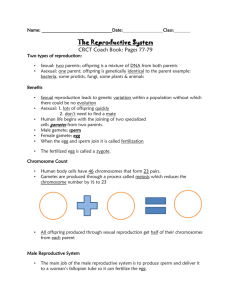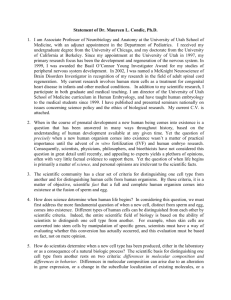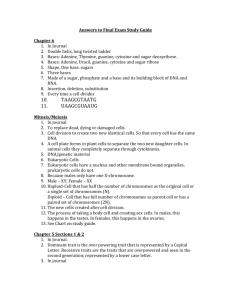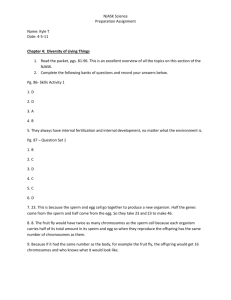Affidavit: Human Life Begins at Fertilization - Dr. Condic
advertisement
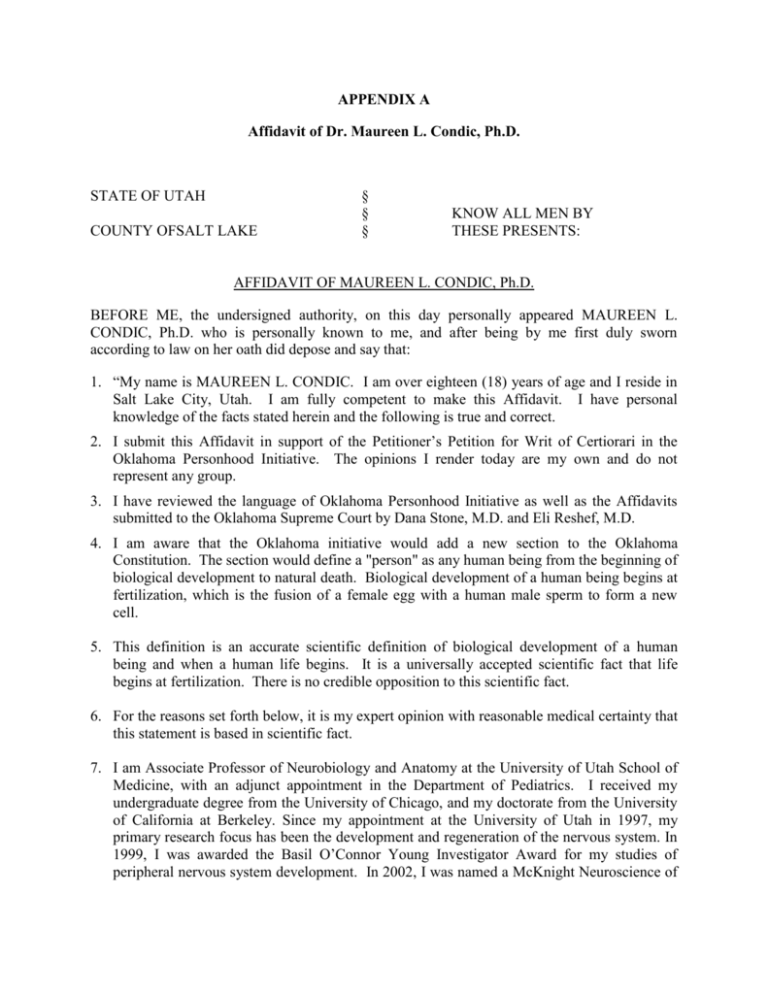
APPENDIX A Affidavit of Dr. Maureen L. Condic, Ph.D. STATE OF UTAH COUNTY OFSALT LAKE § § § KNOW ALL MEN BY THESE PRESENTS: AFFIDAVIT OF MAUREEN L. CONDIC, Ph.D. BEFORE ME, the undersigned authority, on this day personally appeared MAUREEN L. CONDIC, Ph.D. who is personally known to me, and after being by me first duly sworn according to law on her oath did depose and say that: 1. “My name is MAUREEN L. CONDIC. I am over eighteen (18) years of age and I reside in Salt Lake City, Utah. I am fully competent to make this Affidavit. I have personal knowledge of the facts stated herein and the following is true and correct. 2. I submit this Affidavit in support of the Petitioner’s Petition for Writ of Certiorari in the Oklahoma Personhood Initiative. The opinions I render today are my own and do not represent any group. 3. I have reviewed the language of Oklahoma Personhood Initiative as well as the Affidavits submitted to the Oklahoma Supreme Court by Dana Stone, M.D. and Eli Reshef, M.D. 4. I am aware that the Oklahoma initiative would add a new section to the Oklahoma Constitution. The section would define a "person" as any human being from the beginning of biological development to natural death. Biological development of a human being begins at fertilization, which is the fusion of a female egg with a human male sperm to form a new cell. 5. This definition is an accurate scientific definition of biological development of a human being and when a human life begins. It is a universally accepted scientific fact that life begins at fertilization. There is no credible opposition to this scientific fact. 6. For the reasons set forth below, it is my expert opinion with reasonable medical certainty that this statement is based in scientific fact. 7. I am Associate Professor of Neurobiology and Anatomy at the University of Utah School of Medicine, with an adjunct appointment in the Department of Pediatrics. I received my undergraduate degree from the University of Chicago, and my doctorate from the University of California at Berkeley. Since my appointment at the University of Utah in 1997, my primary research focus has been the development and regeneration of the nervous system. In 1999, I was awarded the Basil O’Connor Young Investigator Award for my studies of peripheral nervous system development. In 2002, I was named a McKnight Neuroscience of Brain Disorders Investigator in recognition of my research in the field of adult spinal cord regeneration. 8. In addition to my scientific research, I participate in both graduate and medical teaching. I am director of the University of Utah School of Medicine course in Human Embryology. I have published and presented seminars nationally on issues concerning science policy and the ethics of biological research. 9. My current C.V. is attached as Exhibit “A”. 10. When in the course of prenatal development a new human being comes into existence is a question that has been answered in many ways throughout history, based on the understanding of human development available at any given time. Yet question of precisely when a new human organism comes into existence wasn’t a matter of practical importance until the advent of in vitro fertilization and human embryo research. Consequently, scientists, philosophers, and bioethicists have not considered this question in great detail until recently, and appealing to experts (embryologists and ethicists alike) yields a plethora of opinions, often with very little factual evidence to support them. Yet religious views are irrelevant to the scientific facts. 11. In considering the question of when the life of a new human being commences, we must first address the more fundamental question of when a new cell, distinct from sperm and egg, comes into existence. Human cells can be distinguished from each other by scientific criteria. Indeed, the entire scientific field of biology is based on the ability of scientists to distinguish one cell type from another. Skin cells can be converted into pluripotent stem cells by manipulation of specific genes, but this is clearly a conversion of one cell type to another. No credible scientist would argue that skin cells already “are” pluripotent stem cells or are the “equivalents” of pluripotent stem cells. These are two distinct cell types with distinct properties. The fact that one cell type can give rise to a distinct cell type in no way alters the fact that a new cell type has been produced. 12. How do scientists determine when a new cell type has been produced, either in the laboratory or as a consequence of a natural biologic process? The scientific basis for distinguishing one cell type from another rests on two criteria: differences in molecular composition and differences in behavior. Differences in molecular composition can arise due to an alteration in gene expression, or a change in the subcellular localization of existing molecules, or a chemical modification of existing molecules. Alternatively, when cells exhibit new behavior, for example, going from a quiescent to an actively dividing state, they can be identified as distinct cell types. When a cell exhibits either a change in molecular composition or a change in behavior, it is considered a new cell type. These two criteria are not “religious” or matters of “implicit societal definition or emotional reaction,” they are objective, verifiable scientific criteria that distinguish one cell type from another. 13. Based on these criteria, the fusion of sperm and egg clearly produces a new cell type. The basic events of early development are both reasonably well characterized and entirely uncontested. Following the binding of sperm and egg to each other, the membranes of these two cells fuse, creating in this instant a single hybrid cell: the zygote or one-cell embryo. Cell fusion is a well-studied and very rapid event, occurring in less than a second. Because the zygote arises from the fusion of two different cells, it contains all the components of both sperm and egg, and therefore the zygote has a unique molecular composition that is distinct from either gamete. Subsequent to sperm-egg fusion, events rapidly occur in the zygote that do not normally occur in either sperm or egg. Within minutes of membrane fusion, the zygote initiates changes in its ionic composition that will, over the next 30 minutes, result in chemical modifications that block sperm binding to the cell surface and prevent further intrusion of additional spermatozoa on the unfolding process of development. Thus, the zygote acts immediately and specifically to antagonize the function of the gametes from which it is derived; while the “goal” of both sperm and egg is to find each other and to fuse, the first act of the zygote is immediately to prevent any further binding of sperm to the cell surface. Clearly, then, the prior trajectories of sperm and egg have been abandoned, and a new developmental trajectory—that of the zygote—has taken their place. 14. Based on this factual description of the events following sperm-egg binding, we can confidently conclude that a new cell, the zygote, comes into existence at the “moment” of sperm-egg fusion, an event that occurs in less than a second. At the point of fusion, sperm and egg are physically united—i.e., they cease to exist as gametes, and they form a new entity that is materially distinct from either sperm or egg. The behavior of this new cell also differs radically from that of either sperm or egg: the developmental pathway entered into by the zygote is distinct from both gametes. Thus, sperm-egg fusion is indeed a scientifically well defined “instant” in which the zygote (a new cell with unique genetic composition, molecular composition, and behavior) is formed. 15. What is the nature of this new cell, the zygote, that comes into existence upon sperm-egg fusion? Most importantly, is the zygote merely another human cell (like a liver cell or a skin cell or an egg cell) or is it something else? Just as science distinguishes between different types of cells, it also makes clear distinctions between cellular life and organisms. Both cells and organisms are alive (i.e. they carry out complex metabolic processes to utilize energy and remove wastes), yet organisms exhibit unique behavior and molecular composition that can reliably distinguish them from mere cells. 16. An organism is defined as “(1) a complex structure of interdependent and subordinate elements whose relations and properties are largely determined by their function in the whole and (2) an individual constituted to carry on the activities of life by means of organs separate in function but mutually dependent: a living being.” This definition stresses the interaction of parts in the context of a coordinated whole as the distinguishing feature of an organism. Again, this is not a religious definition; it is a scientific definition that distinguishes human cells from human organisms. 17. Organisms are “living beings.” Therefore, another name for a human organism is a “human being”; an entity that is a complete human, rather than a part of a human or a component of a human. 18. Human beings can be distinguished from human cells using the same kind of criteria scientists use to distinguish different cell types. A human being (i.e., a human organism) is composed of characteristic human parts (cells, proteins, RNA, DNA), yet it is different from a mere collection of cells because it has the characteristic behavior of an organism: it acts in an interdependent and coordinated manner to “carry on the activities of life.” 19. Human embryos from the one-cell (zygote) stage forward show molecular composition that is distinct from other human cells, and more importantly, they show uniquely integrated, organismal behavior that constitutes the scientific definition of a whole human being. The zygote immediately and decisively enters into a complex pattern of development that sequentially produces all of the molecular interactions, cell types, tissues, structures and organs required for the organism as a whole to live and mature as a unique individual. This behavior is entirely unlike the behavior of human cells, and is the defining characteristic of human life. This is not a matter of religious belief, societal convention or emotional reaction. It is a matter of observable, objective scientific fact. 20. Human cells, such as those maintained in laboratories for scientific study, are alive and carry on the activities of cellular life. Under some circumstances, human cells can assemble into primitive tissues and structures, based on local, cell-cell interactions and short-range molecular signaling. Yet under no circumstances do mere human cells exhibit coordinated interactions directed towards the production of a fully integrated human body. They do not produce tissues and organs in a coherent, integrated manner, so as to sustain the life and health of the entity as a whole. They produce parts of the human body (tissues, and in some cases, organs) only in a chaotic, disorganized manner. They behave like cells, not like organisms. Although embryogenesis begins with a single-cell zygote, the complex, integrated process of embryogenesis is the activity of an organism, not the activity of a cell. 21. Based on a scientific description of fertilization, fusion of sperm and egg in the “moment of conception” generates a new human cell, the zygote, with composition and behavior distinct from that of either gamete. Moreover, this cell is not merely a unique human cell, but a cell with all the properties of a fully complete (albeit immature) human organism; it is “an individual constituted to carry on the activities of life by means of organs separate in function but mutually dependent: a living being.” 22. In other words, this new human being has its own unique DNA that is distinct from his/her mother. The doctor has two patients --- the mother and the unborn child. 23. Human embryos can split to form identical twins. Yet the fact that during early human development reproduction can occur asexually by splitting of the embryo is a simple scientific fact that in no way affects the consideration of when human life begins. The fact that a planarian worm can be split into 256 pieces, all of which regenerate an entire worm does not mean that 256 individual worms somehow exist in the original animal. It simply means that the original animal is capable of asexual reproduction by splitting, just as human embryos are for a brief period of time. In cases of twinning, the original organism comes into existence as a consequence of sperm-egg fusion and the twins come into existence as a consequence of embryo splitting at a later time. Whether this reflects the death of the original embryo, and production of two new embryos, or whether the original embryo persists as one of the twins has not been conclusively resolved (although scientific observations on epigenetic modifications of the two twins could potentially address the question). Yet regardless of how this relatively minor point is ultimately resolved, it would not alter the conclusion that the original embryo arose at sperm-egg fusion. 24. The conclusion that human life begins at sperm-egg fusion is objective, based on the universally accepted scientific method of distinguishing different cell types from each other, and it consistent with the factual evidence. It is entirely independent of any specific ethical, moral, political, or religious view of human life or of human embryos. Indeed, this definition does not directly address the central ethical questions surrounding the embryo: What value ought society to place on human life at the earliest stages of development? Does the human embryo possess the same right to life as do human beings at later developmental stages? A neutral examination of the factual evidence merely establishes the onset of a new human life at a scientifically well defined “moment of conception,” a conclusion that unequivocally indicates that human embryos from the zygote stage forward are indeed living individuals of the human species—human beings. 25. Thus, the scientific community does indeed have a clear set of criteria for distinguishing one cell type from another and human cells from human organisms. By these criteria, it is a matter of objective, scientific fact that a full and complete, albeit developmentally immature, human organism comes into existence at the fusion of sperm and egg, and that the resulting zygote is indeed a “human physical life.” Further Affiant sayeth not.” DATED: This day of August, 2012. Dr. Maureen L. Condic, Ph.D SWORN TO AND SUBSCRIBED BEFORE ME, the undersigned authority, on this of August, 2012 NOTARY PUBLIC IN AND FOR THE STATE OF UTAH My commission expires: Notary Public, Salt Lake County, Utah day
